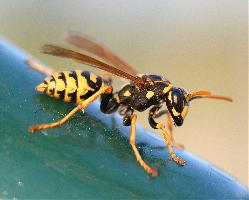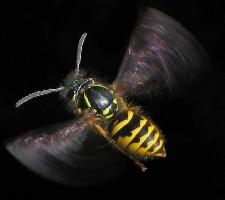
Poids et mesures
| Longueur | de 10 à 16 mm |
|---|
Description de l'animal
The European paper wasp (Polistes dominula), a striking example of social insects within the family Vespidae, has garnered attention for its distinctive appearance and behavior. Originating from the European and North African regions, this species has successfully expanded its range to various parts of the world, including North America, where it is often mistaken for the native yellowjacket due to its similar coloration.Physically, the European paper wasp exhibits a slender body that is predominantly black, adorned with yellow markings that serve as a warning to potential predators about its ability to sting. The species can be distinguished by its long legs, which dangle during flight, and its narrow waist connecting the thorax and abdomen. Adults typically measure between 12 to 16 millimeters in length, with females generally larger than males. Their wings, which are a smoky black color, fold longitudinally when at rest.
One of the most fascinating aspects of Polistes dominula is its nesting behavior. Unlike yellowjackets that build enclosed nests, European paper wasps construct open, umbrella-shaped nests from a paper-like material. This material is produced by mixing wood fibers, collected from weathered wood, with saliva. These nests, often found under eaves, in attics, or on branches, consist of hexagonal cells where eggs are laid and larvae are reared. Each nest is founded by a fertilized female, known as the queen, in the spring. She initially raises the first brood of workers alone, which then assume the responsibilities of foraging, nest expansion, and care of subsequent offspring.
The social structure of Polistes dominula colonies is fascinating, characterized by a dominance hierarchy that is primarily established through physical interactions and signaling. The queen dominates through aggressive behaviors and pheromonal signals, though in some cases, hierarchies can shift, leading to changes in reproductive roles within the colony.
Dietarily, European paper wasps are omnivorous, feeding on nectar and other sugary substances for energy, while also preying on various arthropods to provide protein for their developing larvae. This predatory behavior positions them as natural pest controllers, contributing to the balance of ecosystems by regulating populations of caterpillars and other insects.
The European paper wasp, despite its beneficial role in natural pest control, can pose challenges when it nests in proximity to human activity. Their stings, while typically not aggressive unless provoked, can be painful and, in rare cases, trigger allergic reactions. As such, their presence is often unwelcome in densely populated areas, leading to efforts to manage their populations in such environments.
In summary, the European paper wasp (Polistes dominula) is a highly adaptive and social insect, recognized for its distinctive appearance, complex social structures, and ecological role. While its presence is beneficial for natural pest control, it requires careful management to mitigate conflicts with human populations.
Animaux similaires
Nouvelles photos d'animaux
Top 10 des animaux
- Dolphin gull (Leucophaeus scoresbii)
- Diana monkey (Cercopithecus diana)
- Moustached guenon (Cercopithecus cephus)
- Galápagos tortoise (Geochelone nigra complex)
- Russian tortoise (Testudo horsfieldii)
- Japanese macaque (Macaca fuscata)
- Stone loach (Barbatula barbatula)
- Common flying dragon (Draco volans)
- Greek tortoise (Testudo graeca)
- Vendace (Coregonus albula)


